Blooming hydrangea is a real decoration for a garden or garden. Despite its southern origin, this shrub feels quite comfortable in the Russian climate.
However the plant requires careful care. Pruning hydrangeas in the fall and shelter are prerequisites for a successful wintering.
Content
Pruning targets
Theoretically, hydrangea may well survive without pruning. However, it will not wither and bloom in a timely manner. However, after the procedure, the plant will have a more beautiful and thick crown. In the spring, not only a few small shoots will appear on the bush, but a whole hat of abundant and bright inflorescences will form. If you do not form a crown before the onset of winter, it will gradually take a neglected and sloppy appearance. Such a copy can not be called a decoration of the garden and he will not give any aesthetic pleasure.
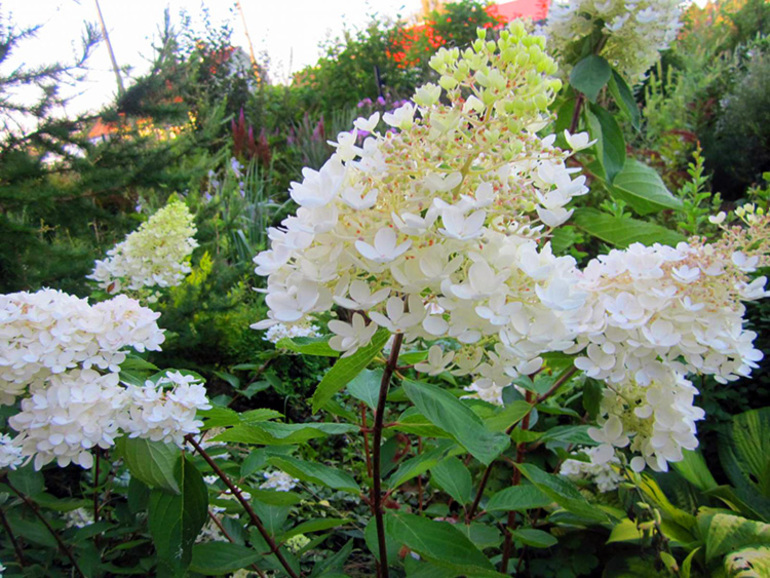
Pruning hydrangea for the winter has several effects:
- forms a beautiful and magnificent crown;
- makes flowering long and plentiful, as a result, the plant pleases the eye throughout the entire warm season;
- rejuvenates hydrangea and preserves its health and attractive appearance for several years;
- contributes to the emergence and rapid growth of new shoots.
Optimal dates
There is no consensus among floriculture experts when it is best to prune hydrangeas in the fall or spring. There are no restrictions on this topic, it all depends on the preferences of a particular gardener.
The benefits of autumn pruning hydrangeas consist in the fact that the shrub at this time is already preparing for a period of rest and ceases to grow new shoots. Since the removal of branches is a traumatic procedure, the plant has a margin of time for restoration.
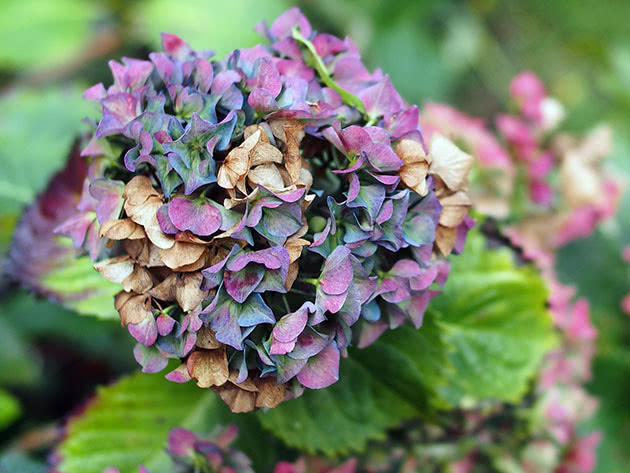 You may be interested in:
You may be interested in: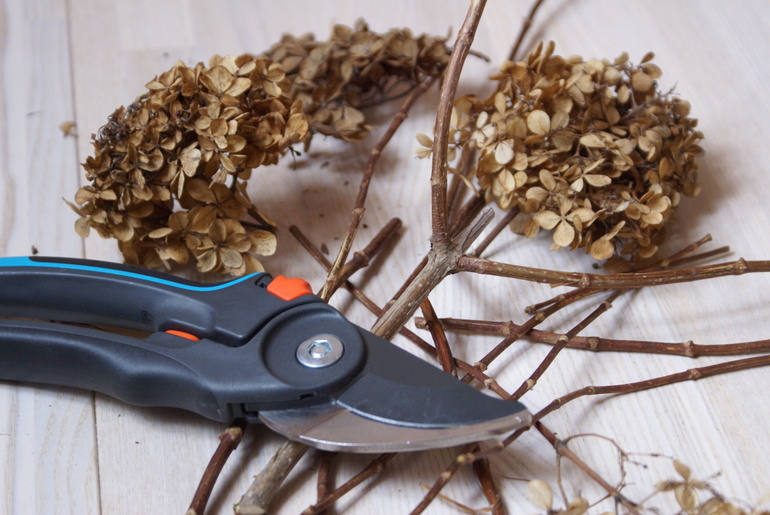
Already in February, hydrangea begins to circulate along the branches of juices, the vital functions of the plant are noticeably activated and pruning without serious consequences will be much more difficult. In addition, in the spring, infection of the shrub with pathogenic bacteria and fungi occurs much more often.
Experienced professionals prefer in the spring to limit themselves to cosmetic treatment. During this period, it is enough to remove all the shoots that have dried up and died out during the winter, as well as those remaining on the inflorescence branches, if they did not have time to remove them before the onset of cold weather. Thus, the bush is given a beautiful well-groomed appearance and a neat shape.
Basic Rules
In Russian gardens, 3 varieties of hydrangeas are most often found. Panicle view has inflorescences of elongated shape, resembling panicles. In the tree-like type, the brushes have a spherical shape, are slightly flattened and are large in size. These 2 species are also called white. Flowers they form on the shoots that have grown this year. Such plants do not require shelter for the winter.
Large-leaved specimens have the same inflorescences-balls, but differ from tree-like ones in a denser leaf plate. Their brushes are formed on last year's shoots. In winter, such hydrangea must be carefully covered. Given the properties of these types of plants, pruning each of them has its own subtleties.
Panicle hydrangeas
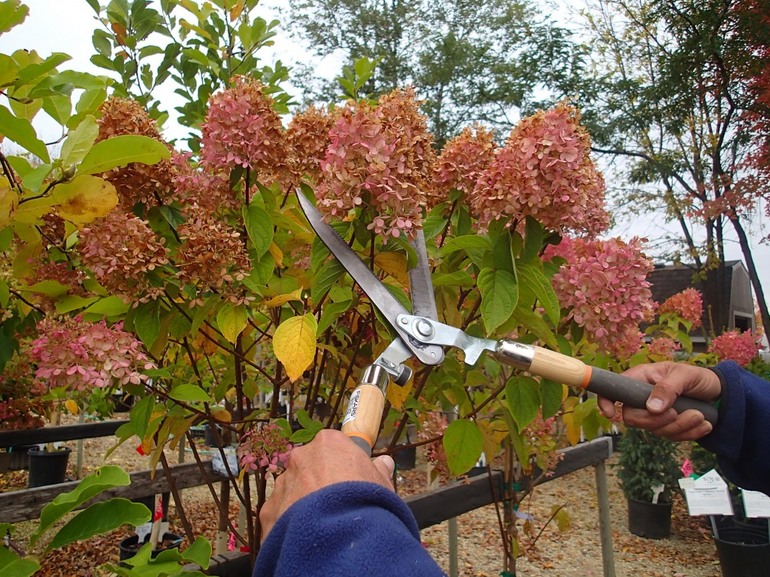
This variety does not need overly pruning. Branches that grow from one point (they are also called skeletal) should not be touched. Only shoots that have grown incorrectly and are directed crookedly or into the bush are subject to removal. Mandatory cut off all inflorescences paniclesthat the flower released on the shoots of the current season. If you leave them for the winter, young branches can not withstand the heaviness of snow and break off.
You need to remove the flowers along with part of the twig. It leaves several lower kidneys for next year. If everything is done correctly, next summer such a bush will have a thick lush crown and look neat and well-groomed. Such pruning panicle hydrangeas in the fall relevant for young specimens.
If the plant has been living on the infield for a long time and needs rejuvenation, it is necessary to examine the bush and choose one of the shoots that grow from a common point. Such a stalk should be the strongest and healthiest, directed outward. All other branches are removed under the spine. With the onset of heat, the extinct shoots are removed from the shoot and give the plant a neat shape.
Tree varieties
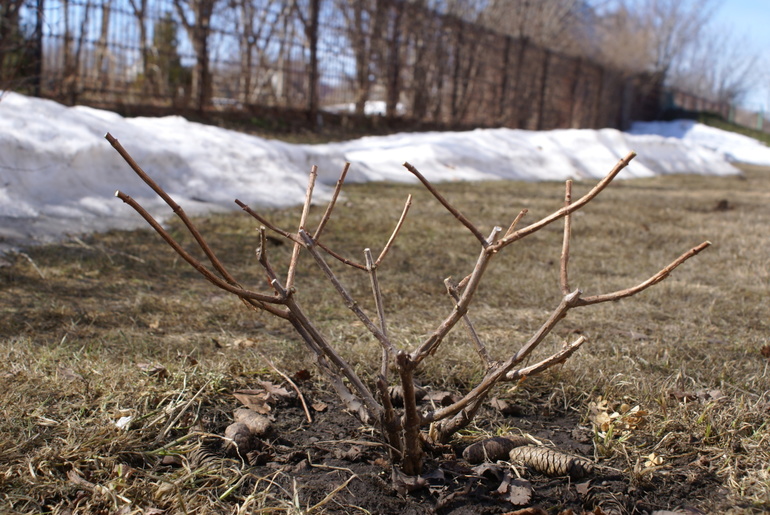
In the first few years after planting, these plants do not need to be trimmed. If you do not follow the rule, the bush may die. In a young plant, it is necessary to remove the inflorescences after they have withered. 3 or 4 pairs of buds are left on the stem without fail.
Next year new young branches will grow from them and a magnificent beautiful crown will be formed. The trimmed shrub is carefully wrapped up and left for the winter.
For more mature bushes spend pruning for rejuvenation. At the same time, all the stems are removed, only stumps with a length of no more than 10 cm should be left. This will provoke the active growth of young shoots next spring. This type of pruning in the fall of hydrangea tree is best done in a gentle way. Stem removal is carried out for 2 or 3 years. Otherwise, there is a risk that the root system does not have enough food and the bush may die.
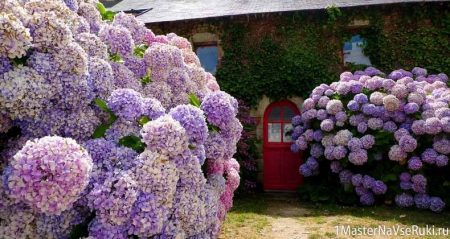 You may be interested in:
You may be interested in: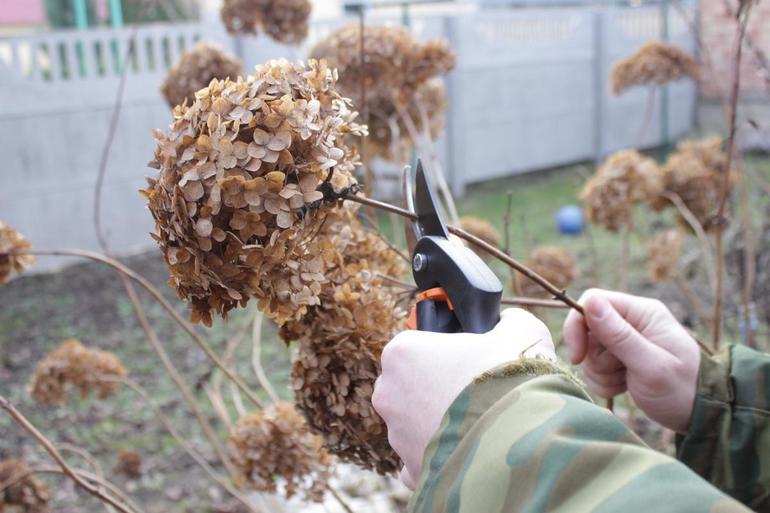
Large-leaved species
This garden hydrangea forms inflorescences on the stems of the second year. Such shoots must be preserved for the winter. With the onset of autumn, cosmetic bush pruning is carried out, weakened, diseased and damaged twigs and faded brushes are removed. Old shoots at the bottom are also best removed. After wintering, young twigs are carefully inspected. Stems affected by frost are cut. Large-leaved plant species often form young shoots on zero shoots, but there are never inflorescences on them.
The principles of autumn pruning are as follows:

- Removal of shoots is carried out immediately after flowering. In this case, young branches form on the bushes before the onset of cold weather.
- All stems directed inside the bush are carefully cut.
- Every 3 years some of the old shoots are removed. This allows you to rejuvenate large-leaf hydrangea and stimulate flowering.
- Before the onset of winter, sick and damaged shoots are cut off.
The intensity of pruning directly depends on the region in which large-leaf hydrangea is grown. If the climate in a particular area is warm and the summer is long, processing can be done deeper.
The most common mistakes
Pruning hydrangeas in the fall for beginners may present some difficulties. In this regard, many gardeners make mistakes. The most common ones include:
- Pruning hydrangea bush in the first 2 years after planting the cuttings. At this time, the plant should gain strength, grow green mass and develop healthy roots.
- Removing shoots in close proximity to the kidneys. As a result of such actions, the hydrangea bush may dry.
If all steps have been taken correctly, hydrangea will delight you with bright and lush flowers for many years.
Care after treatment
If the autumn was rainy, additional watering is not required. If there is little rainfall, the soil needs to be moistened until the thermometer reaches zero. In mid-September, the last top dressing. Fertilizers for this are used with a high content of potassium and phosphorus. These substances will support the root system, which was depleted as a result of summer flowering. You need to make them in granular form, scattering around the trunks and slightly mixing with the soil.
It is strictly forbidden to apply nitrogen fertilizers in the fall. This stimulates the growth of green mass, which is undesirable before the onset of winter. With the advent of frost hydrangea bushes must be covered. The earth around the plant is sprinkled with sawdust or peat.

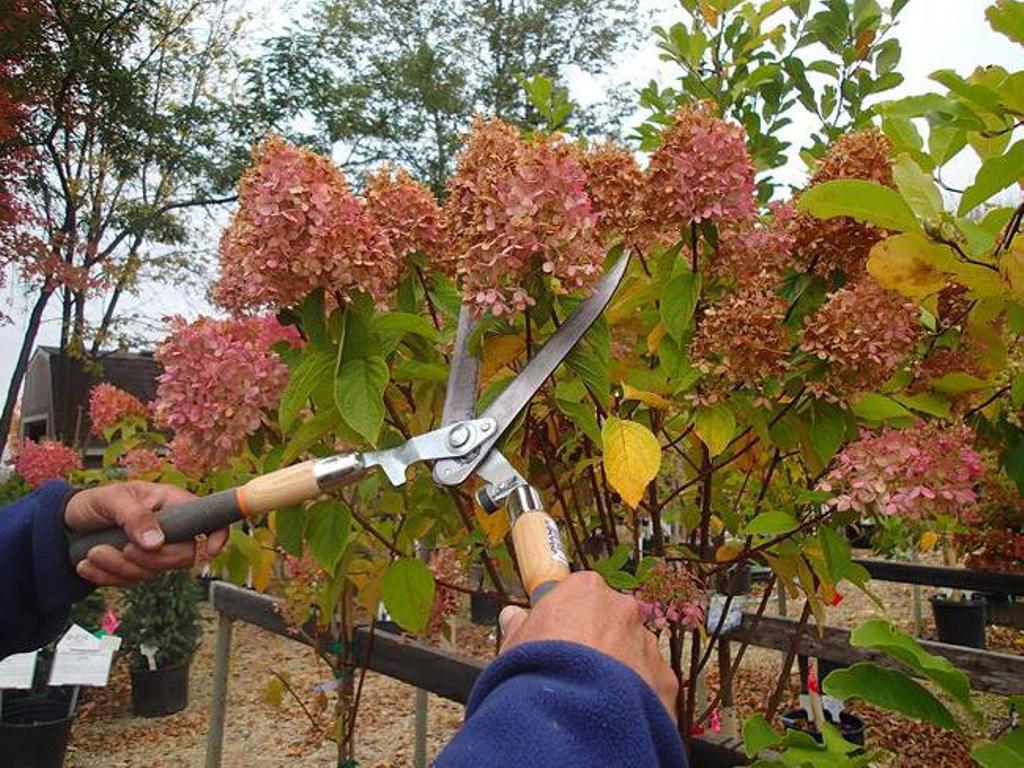 Hydrangea care in the fall and winter preparations
Hydrangea care in the fall and winter preparations How to feed hydrangea for lush flowering
How to feed hydrangea for lush flowering How to hide hydrangea in Siberia for wintering
How to hide hydrangea in Siberia for wintering